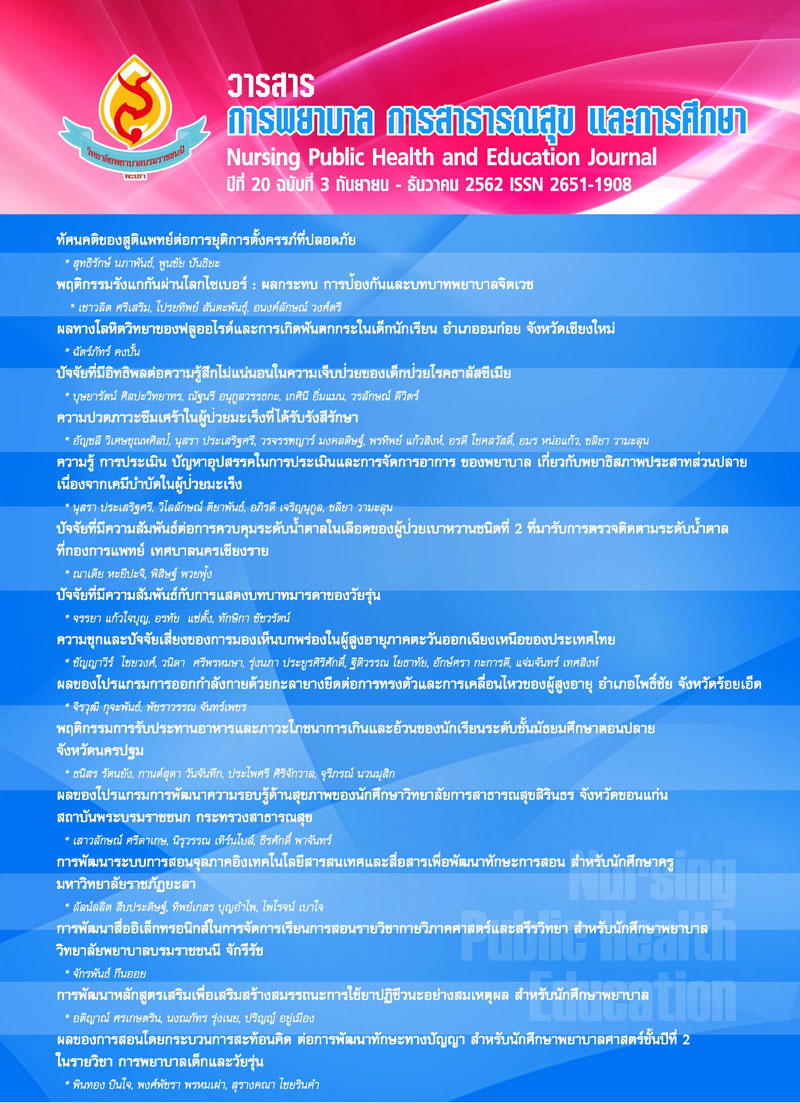พฤติกรรมรังแกกันผ่านโลกไซเบอร์ : ผลกระทบ การป้องกัน และบทบาทพยาบาลจิตเวช
คำสำคัญ:
การรังแกกันผ่านโลกไซเบอร์, สภาวะบีบคั้นทางจิตใจ, วัยรุ่น, พยาบาลจิตเวช, Cyberbullying, psychological distress, adolescent, psychiatric nurseบทคัดย่อ
ปัจจุบันการพัฒนาทางด้านเทคโนโลยีการสื่อสารมีมากขึ้น การเข้าถึงสื่ออิเล็กทรอนิกส์และเครือข่ายอินเตอร์เน็ตของประชาชนเป็นไปอย่างง่ายดาย และมีแนวโน้มการใช้งานที่เพิ่มมากขึ้นอย่างต่อเนื่อง สิ่งเหล่านี้ได้กลายเป็นช่องทางของพฤติกรรมความรุนแรงแบบใหม่ที่เรียกว่า "การรังแกกันผ่านโลกไซเบอร์" ซึ่งเป็นรูปแบบความรุนแรงรูปแบบหนึ่งที่กำลังเกิดขึ้นแพร่หลายในสังคมไทยและสังคมโลกยุคดิจิตัล พฤติกรรมนี้เกิดขึ้นได้ทุกที่ทุกเวลา และแพร่กระจายไปอย่างกว้างขวางได้ในระยะเวลาอันรวดเร็ว เป็นปัญหากับคนทุกกลุ่มวัยโดยเฉพาะอย่างยิ่งในกลุ่มวัยรุ่น พฤติกรรมนี้ถือเป็นอาวุธที่ร้ายแรงรูปแบบหนึ่งที่สามารถทำลายชีวิตของผู้อื่น ก่อให้เกิดความเครียด รวมทั้งนำไปสู่สภาวะบีบคั้นทางจิตใจ และปัญหาทางด้านสุขภาพจิตได้ พยาบาลจิตเวชในฐานะของผู้ที่ทำหน้าที่ส่งเสริมและป้องกันปัญหาสุขภาพจิต มีส่วนสำคัญในการป้องกัน การช่วยเหลือ และลดการเกิดปัญหาสุขภาพจิตจากการเผชิญพฤติกรรมรังแกกันผ่านโลกไซเบอร์ บทความวิชาการนี้มีวัตถุประสงค์เพื่อนำเสนอพฤติกรรมรังแกกันผ่านโลกไซเบอร์ ทั้งความหมาย ปัจจัย รูปแบบพฤติกรรม ผลกระทบ การป้องกัน และบทบาทของพยาบาลจิตเวชในการป้องกันและการจัดการพฤติกรรมรังแกกันผ่านโลกไซเบอร์
Cyberbullying: Impact, Prevention and Role of psychiatric Nursing
At the present, communication technology has been significantly developed. People can easily access to electronic media and internet network and use of those technologies has been continuously increased. In addition, this provides another gateway to a new aggressive behavior which is called ‘Cyberbullying’. The Cyberbullying is one of aggression forms which is widely occurring in Thai society and digital world. Since this behavior can happen anytime and anywhere, it can be distributed extensively within very short period of time. Moreover, this Cyberbullying affects all age group of people, teenagers in particular. This behavior is considered to be a powerful tool for ruination of other people’s lives, causing stress, anxiety, and mental health problems, therefore, as a psychiatric nurse, who is responsible for prevention of mental health issues, should plays an important role in prevention, assistance, and minimize mental disorder caused by Cyberbullying. This article will present issues on cyberbullying behaviors, including meanings, Factors, patterns, impact, prevention and roles of psychiatrict nurses in prevention and management of cyberbullying.
เอกสารอ้างอิง
ทัศนา บุญทอง และเปรมฤทัย น้อยหมื่นไวย. (2553). หน่วยที่ 1 มโนมติของการพยาบาลจิตเวช. ใน ทัศนา บุญทองและคณะ (บรรณาธิการ), เอกสารการสอนชุดวิชาการส่งเสริมสุขภาพ จิตและการพยาบาล จิตเวชหน่วยที่ 1-7. (พิมพ์ครั้งที่ 14). นนทบุรี: มหาวิทยาลัย สุโขทัยธรรมาธิราช.
พิมพวัลย์ บุญมงคล, ราชาวดี เอี่ยมศิลป์, สร้อยฟ้า โต๊ะพันธ์อนันต์, Timo Ojanen, รณภูมิ สามัคคี คารม, รูไวดี สาเมาะ, และคณะ (2555). เพศภาวะ เพศวิถี และการรังแกกันในพื้นที่โลกไซ เบอร์ของวัยรุ่นหญิงไทย. บทความนำเสนอในงานประชุมวิชาการสังคมศาสตร์สุขภาพ ปี 2555 มหาวิทยาลัยมหิดล. โรงแรมรอยัลรีเวอร์ กรุงเทพมหานคร.
วิมลทิพย์ มุสิกพันธ์, สุจินดา ย่องจีน และสาลินี จันทร์เจริญ. (2552).โครงการสำรวจประชามติ พฤติกรรมการข่มเหงรังแกกันผ่านโลกไซเบอร์ของนักเรียน เขตกรุงเทพมหานคร. สืบค้นเมื่อ 13 มกราคม 2557, จาก https://www.wport.org/survey/detail/9
วิไลลักษณ์ พงษ์โสภา. (2555). สุขวิทยาจิต. (พิมพ์ครั้งที่ 1). กรุงเทพฯ : สำนักพิมพ์แห่งจุฬาลงกรณ์ มหาวิทยาลัย.
สำนักนโยบายและส่งเสริมธุรกรรมทางอิเล็กทรอนิกส์. (2556). การรายงานผลการสำรวจพฤติกรรมผู้ใช้อินเทอร์เน็ตในประเทศไทยปี 2556 (Thailand Internet User Profile 2013).กรุงเทพมหานคร: สำนักงานพัฒนาธุรกรรมทำงอิเล็กทรอนิกส์ (องค์การมหาชน) หรือสพธอ.
สุภาวดี เจริญวานิช. (2560). การรังแกกันผ่านพื้นที่ไซเบอร์ : ผลกระทบและการป้องกันในวัยรุ่น Cyber Bullying: Impacts and Preventions in Adolescents. วารสารวิทยาศาสตร์และเทคโนโลยี, 25(4), 640-648.
Ayas, T., & Deniz M. (2014). Predicting the exposure levels of cyber bullying of elementary students with regard to psychological symptoms. ProcediaSocial and Behavioral Sciences, 116, 4910- 4913.
Biesinger, K., Crippen, K. (2008). The impact of an online remediation site on performance related to high school mathematics proficiency. Journal of Computer Math and Sciences, 27, 5–17
Barak, A., & Sadovsky, Y. (2008).Internet use and personal empowerment of hearing-impaired adolescents.Computer in Human Behavior, 24(5), 1802-1815.
Chang, F., Lee, C., Chiu, C., Hsi, W., Huang, T., & Pan, Y. (2013). Relationships among cyberbullying, school bullying, and mental health in Taiwanese adolescents. Journal of School Health, 83(6), 454-462.
Dehue, F., Bolman, C., &Vollink, T. (2008) Cyberbullying: youngsters’ experiences and parental perception.CyberPsychology& Behavior, 11(2), 217–23.
Patchin, J. W., &Hinduja, S. (2014). Summary of our research (2004-2014). Retrieved January 10, 2015, From https://cyberbullying.us/statistics/
Gámez-Guadix, M., Orue, I., Smith, P. K., &Calvete, E. (2013). Longitudinal and reciprocal relations of cyberbullying with depression, substance use, and problematic internet use among adolescents. Journal of Adolescent Health, 53, 446-452.
Goebert, D., Else, I., Matsu, C., Chung-Do, J., & Chang, J. (2011). The impact of Cyberbullying on substance use and mental health in a multiethnic sample. Maternal & child health journal,15(8), 1282-1286.
Guan, S. A., &Subrahmanyam, K. (2009). Youth internet use: Risks and opportunities. Current Opinion in Psychiatry, 22, 351–356.
Hinduja, S., & Patchin, J. W. (2008).Cyberbullying: An exploratory analysis of factors related to offending and victimization. Deviant Behavior, 29(1), 129-156.
Langos, C. (2012).Cyberbullying: The challenge to define. Cyberpsychology, Behavior, and Social Networking, 15(6), 285-289.
Kowalski, R. M., & Limber, S. P. (2012). Psychological, physical, and academic correlates of cyberbullying and traditional bullying. Journal of adolescent health,53(1), S13-20.
Ngo, A. D., Ross, M. W., &Ratliff, E. A. (2008). Internet influences on sexual practices among young people in Hanoi, Vietnam.Culture, Health & Sexuality, 10(6), S201-S213.
Olweus, D. (2003). A profile of bullying at school. Educational Leadership, 60(6), 12–17.
Patchin, J. W., & Hinduja, S. (2010). Cyberbullying and self-esteem. Journal of school health, 80(12), 614-621.
Schmitt, K. L., Dayanim, S., & Matthias, S. (2008). Personal homepage construction as an expression of social development. Development Psychology, 44(2), 496-506.
Schenk, A. M., & Fremouw, W. J. (2012). Prevalence, psychological impact, and coping of cyberbully victims among college students. Journal of school violence, 11(1), 21-37.
Schneider, S. K., O'Donnell, L., & Stueve, A. S. (2012). Cyberbullying, school bullying, and psychological distress: A regional census of high school students. American journal of public health, 102(1), 171-177.
Shariff, S., & Gouin, R. (2005). Cyber-dilemmas: Gendered hierarchies, free expression and cyber-safety in schools. In Safety and security in a networked world: Balancing cyberrights and responsibilities. Oxford, UK: Oxford Internet Institute.
Smith, P. K., Mahdavi, J., Carvalho, M., Fisher, S.,Russell, S.,&Tippett, N. (2008). Cyberbullying: Its nature and impact in secondary school pupils. Journal of Child Psychology and Psychiatry, 49(4), 376–385.
Sourander, A., Brunstein Klomek, A., Ikonen, M., Lindroos, J., Luntamo, T., Koskelainen, M., … Helenius, H. (2010). Psychosocial risk factors associated with cyberbullying among adolescents: A population-based study. Archives of General Psychiatry, 67(7), 720-728.
Tokunaga, R. S. (2010). Following you home from school: A critical review and synthesis of research on cyberbullying victimization.Computers in Human Behavior, 26, 277–287.
Udris, R. (2015). Cyberbullying in Japan: An Exploratory Study. International Journal of Cyber Society and Education, 8(2), 59-80
Wang, J., & Iannotti, R. J. (2012). Bullying among U.S. adolescents. The Prevention Researcher, 19(3), 3- 6. Retrieved from https://blog.tpronline. org/?p=2293
Wang, J., Nansel, T.R., Iannotti, R.J. (2011). Cyber and traditional bullying: Differential association with depression. Journal of Adolescent Health, 48(4), 415-417.
Willard, N. (2007). Cyberbullying and cyberthreats effectively managing internet use risks in schools. Retrieved April 16, 2014, from https://csriu.org
Zhou, Z., Tang, H., Tian, Y., Wei, H., Zhang, F., & Morrison, C. M. (2013). Cyberbullying and its risk factors among Chinese high school students. School psychology international, 34(6), 630-647.



